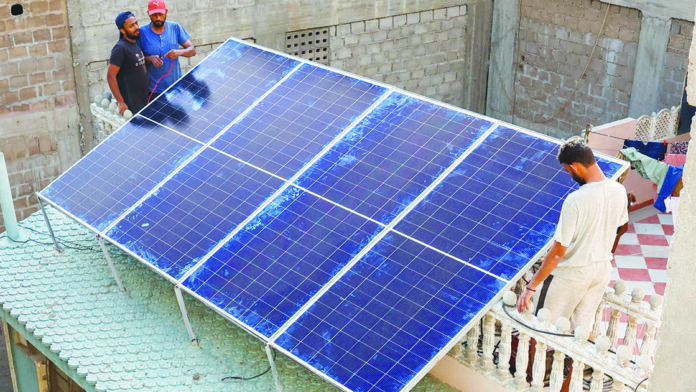Pakistan’s energy dilemma has reached a critical point, where despite substantial capacity, the nation remains trapped in a cycle of frequent blackouts. As of March, Pakistan’s total installed electricity stands at 42,131 MW. Yet, despite this capacity, the country faces a persistent energy crisis. The maximum demand from residential and industrial sectors reaches nearly 31,000 MW, but Pakistan’s outdated transmission and distribution infrastructure can only handle around 22,000 MW. This results in a deficit of approximately 9,000 MW during peak hours. While projects are underway to boost electricity production by 2030, these long-term plans will not address our immediate challenges. The short-term solution lies in harnessing our abundant solar energy potential, offering a more sustainable and immediate fix to the ongoing power shortages.
According to the recent statistics, fossil fuels generated about 59 percent of the country’s power, with hydropower and nuclear energy following at 25.4 percent and 8.4 percent respectively. However, renewable energy lagged at just 6.8 percent. This trend is starting to change in recent years. Pakistan boasts a tremendous potential for solar energy. According to the World Bank, it could generate up to 40 GW of solar power. Recognising this need, the government, under its Alternative and Renewable Energy Policy has also set up an ambitious goal to source as much as 20 percent of its electricity from renewable sources by 2025.
While the policy promises several incentives and support for renewable energy projects across the nation, the current energy profile of Pakistan, fraught with challenges such as energy losses in generation, transmission and distribution, as well as outdated infrastructure, raises concerns over the validity of such plans. In the face of these challenges, a growing awareness over the dire need for sustainable energy solutions has gained a lot of traction.
Solar power can offer several incentives to Pakistan. The Net Metering Policy, by allowing owners to feed excess electricity back into the national grid and receive credits for it, would significantly reduce bills. Moreover, individuals and businesses can take advantage of income tax credits, import duty exemptions on solar equipment, and reduced sales tax on solar components for long-term savings on energy bills.
After a few years of promoting benefits of fast-track solarisation, the government faces a complex balancing act in its energy policy, where it must prioritise both economic development and human welfare, while addressing the pressing demand of the current financial crises. One of the major concerns is the potential strain on the government if there is a large-scale shift to solar energy, as Rs. 2.1 trillion in capacity payments to Independent Power Producers (IPPs) are anticipated for the fiscal year 2024-25.
Therefore, In spite of numerous benefits of solar energy and the growing awareness of its potential, there exists a critical issue that needs to be addressed: the recent debates over switching from net metering to gross metering, and creating a distinct tariff category for solar users. According to the gross metering policy, solar energy generated on the rooftop will be fed directly into the national grid. In turn, this could lead to higher costs for consumers as financial benefits from generating independent power are diminished.
The government, on its part, provides a rationale that benefits of solar technology disproportionately favours the wealthy, leaving the broader population bearing a large share of infrastructure costs, as fixed costs such as Capacity Purchase Price (CPP) and Distribution/Supply Cost remain unaffected by adoption of solar power.
However, in Pakistan, the adoption of solar energy is increasingly becoming a practical necessity. Solar energy has also made significant inroads into rural areas, where small-scale solar systems, like Solar Home Systems (SHS), provide reliable energy for essentials such as tubewells and other agricultural machinery. These systems eliminate the ongoing costs of grid electricity and expensive diesel generators, offering rural families a quick return on investment by removing the need for traditional, unreliable energy sources.
Therefore, the debate surrounding solar energy adoption should not be framed solely as a rich versus poor issue. The real challenge lies in the structural problems posed by Independent IPPs, who have been a significant contributor to the high cost of electricity in
Pakistan, largely due to the onerous terms of the power purchase agreements (PPAs) they operate under. This issue affects all segments of society, regardless of income level, and underscores the importance of addressing the root causes of high energy costs.
The real solution to Pakistan’s energy challenges lies in embracing solar energy. Solar power not only reduces dependency on costly IPPs but also offers long-term price stability and democratises energy access for all, making it a sustainable and equitable choice for the nation’s future.























